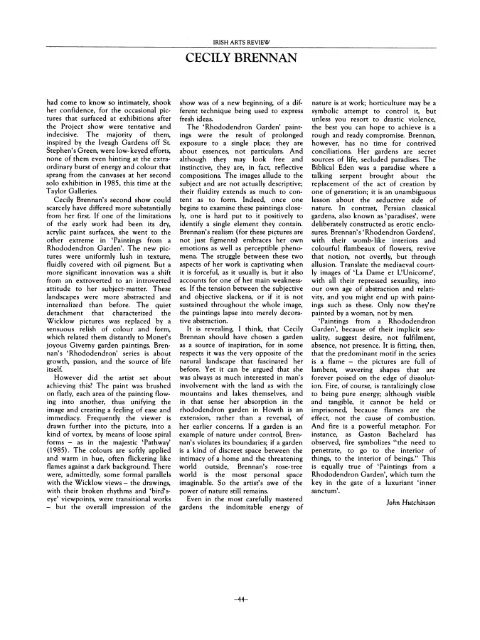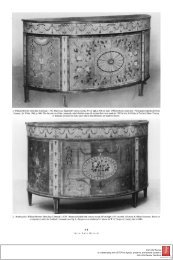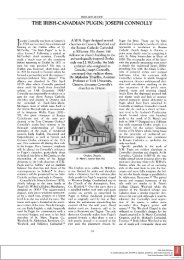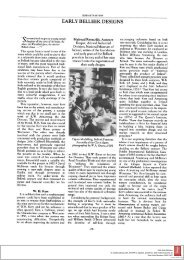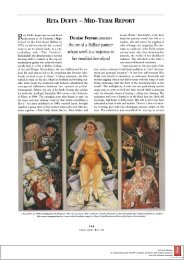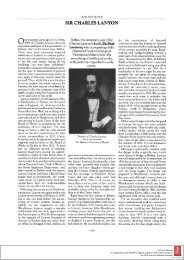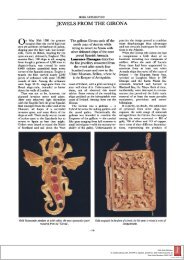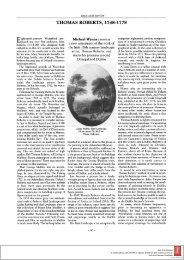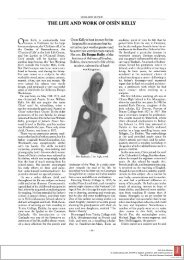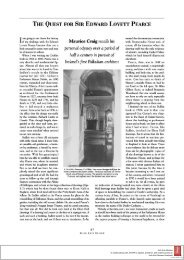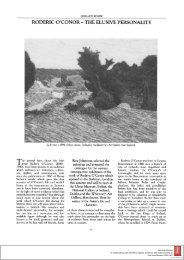CECILY BRENNAN - Irish Arts Review
CECILY BRENNAN - Irish Arts Review
CECILY BRENNAN - Irish Arts Review
Create successful ePaper yourself
Turn your PDF publications into a flip-book with our unique Google optimized e-Paper software.
had come to know so intimately, shook<br />
her confidence, for the occasional pic<br />
tures that surfaced at exhibitions after<br />
the Project show were tentative and<br />
indecisive. The majority of them,<br />
inspired by the Iveagh Gardens off St.<br />
Stephen's Green, were low- keyed efforts,<br />
none of them even hinting at the extra<br />
ordinary burst of energy and colour that<br />
sprang from the canvases at her second<br />
solo exhibition in 1985, this time at the<br />
Taylor Galleries.<br />
Cecily Brennan's second show could<br />
scarcely have differed more substantially<br />
from her first. If one of the limitations<br />
of the early work had been its dry,<br />
acrylic paint surfaces, she went to the<br />
other extreme in 'Paintings from a<br />
Rhododendron Garden'. The new pic<br />
tures were uniformly lush in texture,<br />
fluidly covered with oil pigment. But a<br />
more significant innovation was a shift<br />
from an extroverted to an introverted<br />
attitude to her subject-matter. These<br />
landscapes were more abstracted and<br />
internalized than before. The quiet<br />
detachment that characterized the<br />
Wicklow pictures was replaced by a<br />
sensuous relish of colour and form,<br />
which related them distantly to Monet's<br />
joyous Giverny garden paintings. Bren<br />
nan's 'Rhododendron' series is about<br />
growth, passion, and the source of life<br />
itself.<br />
However did the artist set about<br />
achieving this? The paint was brushed<br />
on flatly, each area of the painting flow<br />
ing into another, thus unifying the<br />
image and creating a feeling of ease and<br />
immediacy. Frequently the viewer is<br />
drawn further into the picture, into a<br />
kind of vortex, by means of loose spiral<br />
forms - as in the majestic 'Pathway'<br />
(1985). The colours are softly applied<br />
and warm in hue, often flickering like<br />
flames against a dark background. There<br />
were, admittedly, some formal parallels<br />
with the Wicklow views - the drawings,<br />
with their broken rhythms and 'bird's<br />
eye' viewpoints, were transitional works<br />
- but the overall impression of the<br />
IRISH ARTS REVIEW<br />
<strong>CECILY</strong> <strong>BRENNAN</strong><br />
show was of a new beginning, of a dif<br />
ferent technique being used to express<br />
fresh ideas.<br />
The 'Rhododendron Garden' paint<br />
ings were the result of prolonged<br />
exposure to a single place; they are<br />
about essences, not particulars. And<br />
although they may look free and<br />
instinctive, they are, in fact, reflective<br />
compositions. The images allude to the<br />
subject and are not actually descriptive;<br />
their fluidity extends as much to con<br />
tent as to form. Indeed, once one<br />
begins to examine these paintings close<br />
ly, one is hard put to it positively to<br />
identify a single element they contain.<br />
Brennan's realism (for these pictures are<br />
not just figments) embraces her own<br />
emotions as well as perceptible pheno<br />
mena. The struggle between these two<br />
aspects of her work is captivating when<br />
it is forceful, as it usually is, but it also<br />
accounts for one of her main weakness<br />
es. If the tension between the subjective<br />
and objective slackens, or if it is not<br />
sustained throughout the whole image,<br />
the paintings lapse into merely decora<br />
tive abstraction.<br />
It is revealing, I think, that Cecily<br />
Brennan should have chosen a garden<br />
as a source of inspiration, for in some<br />
respects it was the very opposite of the<br />
natural landscape that fascinated her<br />
before. Yet it can be argued that she<br />
was always as much interested in man's<br />
involvement with the land as with the<br />
mountains and lakes themselves, and<br />
in that sense her absorption in the<br />
rhododendron garden in Howth is an<br />
extension, rather than a reversal, of<br />
her earlier concerns. If a garden is an<br />
example of nature under control, Bren<br />
nan's violates its boundaries; if a garden<br />
is a kind of discreet space between the<br />
intimacy of a home and the threatening<br />
world outside, Brennan's rose-tree<br />
world is the most personal space<br />
imaginable. So the artist's awe of the<br />
power of nature still remains.<br />
Even in the most carefully mastered<br />
gardens the indomitable energy of<br />
-44<br />
nature is at work; horticulture may be a<br />
symbolic attempt to control it, but<br />
unless you resort to drastic violence,<br />
the best you can hope to achieve is a<br />
rough and ready compromise. Brennan,<br />
however, has no time for contrived<br />
conciliations. Her gardens are secret<br />
sources of life, secluded paradises. The<br />
Biblical Eden was a paradise where a<br />
talking serpent brought about the<br />
replacement of the act of creation by<br />
one of generation; it is an unambiguous<br />
lesson about the seductive side of<br />
nature. In contrast, Persian classical<br />
gardens, also known as 'paradises', were<br />
deliberately constructed as erotic enclo<br />
sures. Brennan's'Rhodendron Gardens',<br />
with their womb-like interiors and<br />
colourful flambeaux of flowers, revive<br />
that notion, not overtly, but through<br />
allusion. Translate the mediaeval court<br />
ly images of 'La Dame et L'Unicorne',<br />
with all their repressed sexuality, into<br />
our own age of abstraction and relati<br />
vity, and you might end up with paint<br />
ings such as these. Only now they're<br />
painted by a woman, not by men.<br />
'Paintings from a Rhododendron<br />
Garden', because of their implicit sex<br />
uality, suggest desire, not fulfilment,<br />
absence, not presence. It is fitting, then,<br />
that the predominant motif in the series<br />
is a flame - the pictures are full of<br />
lambent, wavering shapes that are<br />
forever poised on the edge of dissolut<br />
ion. Fire, of course, is tantalizingly close<br />
to being pure energy; although visible<br />
and tangible, it cannot be held or<br />
imprisoned, because flames are the<br />
effect, not the cause of combustion.<br />
And fire is a powerful metaphor. For<br />
instance, as Gaston Bachelard has<br />
observed, fire symbolizes "the need to<br />
penetrate, to go to the interior of<br />
things, to the interior of beings." This<br />
is equally true of 'Paintings from a<br />
Rhododendron Garden', which turn the<br />
key in the gate of a luxuriant 'inner<br />
sanctum'.<br />
John Hutchinson


